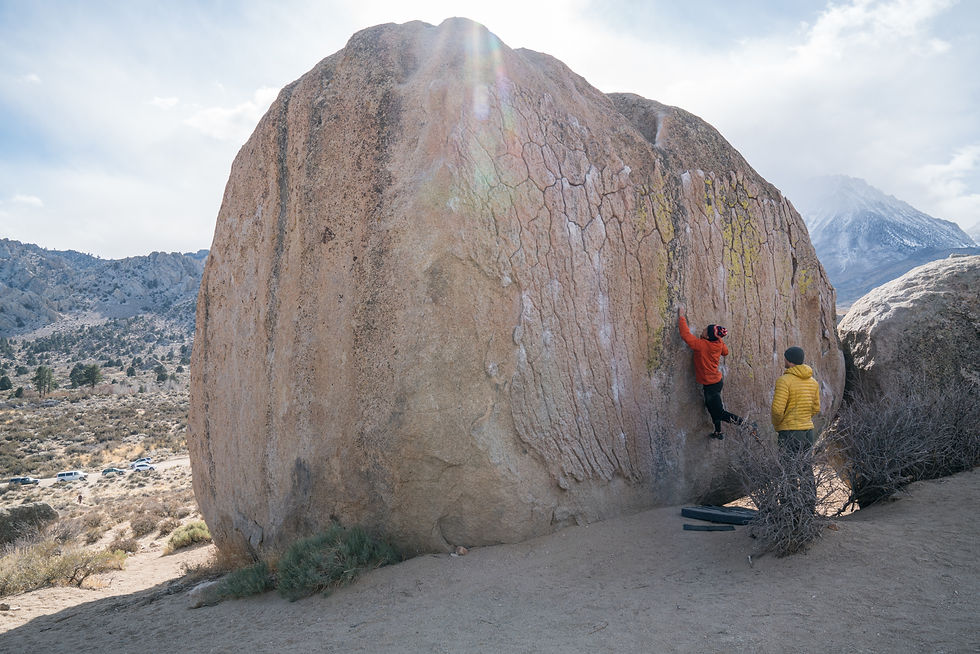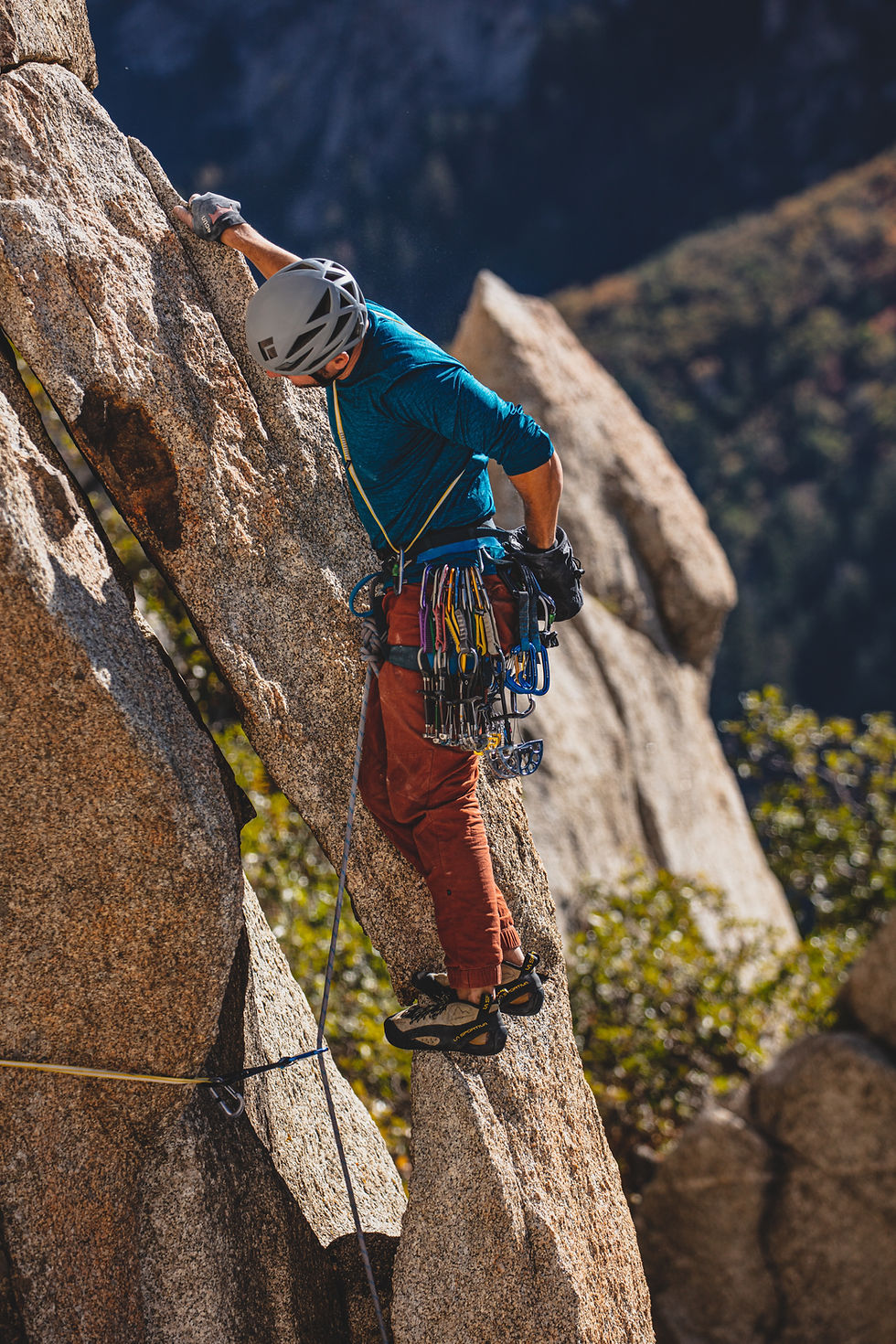What Kinds of Rock Climbing Are There?
- ComprehensiveClimbers

- Apr 14, 2020
- 4 min read
Updated: Apr 15, 2020
Let's start by saying that climbing is inherently dangerous, even if you are knowledgeable and skilled there is no guarantee of safety. In light of that, no matter what style of climbing you choose, consider the risks and always keep safety protocols top of mind - not just for yourself but for those you climb with and around as well!
Okay, now that that's out of the way we can get into the topic that brought you here:
If you're a beginner climber you're probably asking yourself "what types of rock climbing there are?" There are many climbing styles, we could jump down the rabbit hole but for now, let's just dip our toes in - in this article, we'll go over three common styles of rock climbing: Bouldering, Sport Climbing, and Trad Climbing.

In this photo: A Climber (left) makes their way up a route, crash pads below them for safety
Bouldering -
A form of climbing on 'small' (i.e. boulders that break off from cliffs, not necessarily 'small') rock formations or artificial walls.
This type of climbing does not require protective equipment like helmets, harnesses, and ropes. Equipment required for bouldering is fairly minimal, boulderers typically use climbing shoes, a chalk bag, and a crash pad to break their fall. Because it requires minimal equipment and technical know-how, bouldering is a great way to start climbing.
What's bouldering like? Depending on where you live, your bouldering experience will vary.
If you're at a climbing gym, you'll likely find yourself in a room full of people hanging out, taking turns climbing the graded routes (AKA: problems) that trained routesetters put up. Artificial bouldering walls (usually between 10-15 ft tall) will have mats underneath them to soften your fall. Climbing gyms are a great way to explore the sport and meet other climbing enthusiasts. Gyms typically offer introductory classes for new climbers so be sure to take advantage of them if you're just starting out!
When you're ready to get outside, you'll likely use a guidebook or an online resource like mountain project. You'll travel to a location, scope out the area, find some boulders, review your guidebook (they'll tell you where and which grade the established routes are), and then you'll climb! Keep in mind: unlike the gym, outdoor boulders do not offer any kind of protection against falls, so make sure to lug a crash pad (or two, or three) up with you when you head out!

In this photo: A lead climber clips their rope into a quickdraw that they attached to a bolt
Sport Climbing -
Sport Climbing is the act of climbing a rock face utilizing permanently-fixed anchors and bolts drilled into the rock by route developers. Sport climbing routes are longer and taller than bouldering routes so they require protective equipment like helmets, harnesses, ropes, belay devices, and more. Because sport climbing requires more equipment and technical know-how, it's a good idea to start at the gym or in a controlled environment so you can hone your skills before you get outside.
If you visit a rock climbing gym that has ropes, you're essentially sport climbing. There are different tests that you will have to do before you have the freedom to top-rope belay, lead belay, or lead climb. Belaying is the act of managing a rope while a climber is on the wall, the belayer (the person on the ground managing the rope) will either feed the rope through a belay device or pull in slack while the climber moves up the route.
When you sport climb, you can either lead the climb or follow on top-rope.
Lead Climbing
A lead climber ascending a route will carry a rope and quickdraws (two carabiners connected by a semi-rigid material) up with them, clipping into the bolts on the way up, and into the anchor at the end of the climb. While the lead climber is making their way up, their belayer will manage the rope, feeding the rope up or taking slack in depending on where the lead climber is in relation to the last piece of protection.
When the lead climber has finished the climb, they can set up a top-rope for the next climber if the next climber does not want to lead the route. Which brings us to top-rope climbing:

In this photo: A belayer (right) pulls in slack while the climber (left) ascends the route
Top-Rope Climbing
If the lead climber sets up a top-rope for the next climber, the rope will be fed through the anchor at the top of the climb and will extend back down to the climber on one side and the belayer on the other (see above photo for visual reference). As the top-rope climber makes their way up the route, the belayer will take in slack (they will not feed slack like they would for a lead climber). Once the climber reaches the top, they can either lower or rappel back down to the ground.
Last, we have trad (traditional) climbing:

Trad (traditional) Climbing
Trad climbing is similar to sport climbing but instead of clipping into permanently-fixed bolts and anchors, the climber must place their own protective gear (i.e. cams and nuts) as they ascend the route and remove it when the climb is complete.
There are some bolted trad routes but the placement of bolts is far-spread, there can be 15-80 ft between bolts on a trad line, whereas sport routes usually have bolts 5-10 ft apart.
Because trad climbers must place their own protective gear on the route, they spend a lot of time assessing risk, meticulously placing gear, and practicing self-sufficiency, whereas sport climbers, who do not need to focus so much on gear placement, can focus more on physical strength and performance while climbing a route.

Let's finish this post by reiterating by that climbing is inherently dangerous, even if you are knowledgeable and skilled there is no guarantee of safety. So, no matter what style of climbing suites you, make sure you educate yourself on the ethics and safety protocols of the sport - not just for yourself, but for those you climb with and around as well!
Thanks for reading & stay tuned for our next blog post!
Additional Resources:
Climbing Terminology
Map of commercial climbing gyms
Mountain Project Climbing Gym Directory
Mountain Project - Online Climbing Guide
More Types of Climbing:
Mixed
Aid
Ice
Alpine
Free Solo
Deep Water solo
Big Wall

Comments